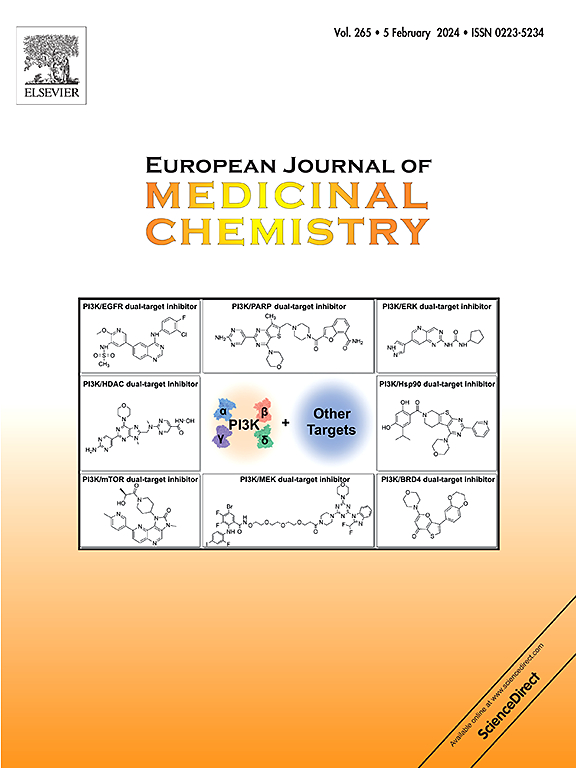Targeting both wild-type EGFR and its drug-resistant mutants with erlotinib-aptamer conjugates
IF 6
2区 医学
Q1 CHEMISTRY, MEDICINAL
引用次数: 0
Abstract
The epidermal growth factor receptor (EGFR) mutation is an actionable oncogenic driver in non-small-cell lung cancer (NSCLC). Although multiple generations of EGFR-tyrosine kinase inhibitors (EGFR-TKIs) have been approved for the treatment of advanced NSCLC, acquired drug resistance after long-term administration challenges their therapeutic efficacy. In this study, using the first-generation agent erlotinib as a warhead for EGFR and an aptamer targeting insulin-like growth factor 2 receptor (IGF2R) as a recruiter for the lysosome-shuttling receptor, we develop a pan-EGFR lysosome-targeting chimera (LYTAC). A series of EGFR degraders with different linker lengths are generated, among which LY-dE#5 is the most effective degrader that directs EGFR to the lysosomal pathway for degradation. Importantly, LY-dE#5 drives not only the downregulation of the wild-type but also the mutants which include 19del, L858R/T790M, 19del/T790M/C797S, and L858R/T790M/C797S, exhibiting superior antitumor activity over Osimertinib. Further in vitro and in vivo studies demonstrate that LY-dE#5 effectively suppresses the growth of EGFR-driven cancer cells. These data indicate that the erlotinib-aptamer conjugate is an efficient pan-EGFR degrader that holds the translational potential for cancer treatment to overcome the common drug-resistance issues of EGFR-TKIs.

用厄洛替尼适体偶联物靶向野生型EGFR及其耐药突变体
表皮生长因子受体(EGFR)突变是非小细胞肺癌(NSCLC)的一个可操作的致癌驱动因素。尽管多代egfr -酪氨酸激酶抑制剂(EGFR-TKIs)已被批准用于晚期NSCLC的治疗,但长期给药后获得性耐药挑战了其治疗效果。在这项研究中,我们使用第一代药物厄洛替尼作为EGFR的弹头,并使用靶向胰岛素样生长因子2受体(IGF2R)的适体作为溶酶体穿梭受体的招募者,开发了泛EGFR溶酶体靶向嵌合体(LYTAC)。产生了一系列不同连接体长度的EGFR降解物,其中LY-dE#5是最有效的降解物,可将EGFR引导至溶酶体途径降解。重要的是,LY-dE#5不仅驱动野生型的下调,还驱动包括19del, L858R/T790M, 19del/T790M/C797S和L858R/T790M/C797S在内的突变体,表现出优于奥西替尼的抗肿瘤活性。进一步的体外和体内研究表明,LY-dE#5有效抑制egfr驱动的癌细胞的生长。这些数据表明,厄洛替尼适体偶联物是一种有效的泛egfr降解物,具有克服EGFR-TKIs常见耐药问题的癌症治疗转化潜力。
本文章由计算机程序翻译,如有差异,请以英文原文为准。
求助全文
约1分钟内获得全文
求助全文
来源期刊
CiteScore
11.70
自引率
9.00%
发文量
863
审稿时长
29 days
期刊介绍:
The European Journal of Medicinal Chemistry is a global journal that publishes studies on all aspects of medicinal chemistry. It provides a medium for publication of original papers and also welcomes critical review papers.
A typical paper would report on the organic synthesis, characterization and pharmacological evaluation of compounds. Other topics of interest are drug design, QSAR, molecular modeling, drug-receptor interactions, molecular aspects of drug metabolism, prodrug synthesis and drug targeting. The journal expects manuscripts to present the rational for a study, provide insight into the design of compounds or understanding of mechanism, or clarify the targets.

 求助内容:
求助内容: 应助结果提醒方式:
应助结果提醒方式:


